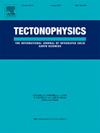青藏高原东部的应力异质性及其对当今高原扩张的影响
IF 2.7
3区 地球科学
Q2 GEOCHEMISTRY & GEOPHYSICS
引用次数: 0
摘要
青藏高原东扩导致青藏高原东部出现了不同类型的地震,但其机理尚不清楚。在此,我们构建了一个考虑地形的三维粘弹性有限元模型,以研究断层几何形状和流变异质性对应力场的影响。在我们的最佳拟合模型中,由于中低纬地壳侧向流变异质性显著,与龙门山断裂带相邻的南虎牙断裂带附近的最小主应力近乎垂直,而反向断层和推力为主的地震则由推力应力机制引起。在这种情况下,中下地壳向东的水平运动受阻,有利于推力断层的形成,表明青藏高原向东扩展有限。与此相反,东昆仑断裂的末端分支之一--虎牙断裂带北部,容纳了东昆仑断裂的持续向东挤压,在地壳更加均匀的情况下,应力机制有利于走向滑动断层的形成过程,并伴随着主要的走向滑动地震。此外,应力机制的最佳拟合解释了龙门山断裂带上以推力为主的 2008 年汶川 8.0 级地震和 2013 年芦山 7.0 级地震。结合地球物理和大地测量观测结果以及模型分析,我们提出青藏高原东部的混合变形模式是由上地壳剪切变形和推覆变形以及重力势能梯度驱动的中下地壳增厚所决定的。我们的研究结果阐明了历史强震的差异机制,更重要的是,将断层几何与异质粘度对青藏高原东部地壳变形和应力异质性的影响分离开来。本文章由计算机程序翻译,如有差异,请以英文原文为准。
Stress heterogeneity in the eastern Tibetan Plateau and implications for the present-day plateau expansion
The eastward expansion of the Tibetan Plateau has resulted in different earthquake types in the eastern Tibetan Plateau, but the mechanism remains unclear. Here, we construct a three-dimensional visco-elastoplastic finite element model considering the topography to investigate the influence of fault geometry and rheological heterogeneity on stress fields. In our best-fitting model, the minimum principal stress is nearly vertical around the southern Huya fault zone, which is adjacent to the Longmen Shan fault zone, due to the significant mid-lowerWE crust lateral rheological heterogeneity, and the thrust stress regime accounts for the reverse fault and thrust-dominated earthquakes. In this scenario, the eastward horizontal motion of the mid-lower crust is obstructed and facilitates thrust faulting, suggesting the limited eastward expansion of the Tibetan Plateau. In contrast, the northern Huya fault zone, one of the terminal branches of the East Kunlun fault, accommodates the continuous eastward extrusion of the East Kunlun fault, where the stress regime under a more homogenized crust favors the strike-slip faulting process, along with the dominant strike-slip earthquakes. Moreover, the best-fitting of stress regime explains the thrust-dominated 2008 Ms. 8.0 Wenchuan and 2013 Ms. 7.0 Lushan earthquakes on the Longmen Shan fault zone. Combining geophysical and geodetic observations and model analyses, we propose that the hybrid deformation mode in the eastern Tibetan Plateau is accommodated by upper crustal shear and thrusting deformation and mid-lower crustal thickening driven by the gravitational potential energy gradient. Our results elucidate the mechanism for differences in strong historical earthquakes and, more importantly, isolate the effect of fault geometry from those of heterogeneous viscosity on crustal deformation and stress heterogeneity in the eastern Tibetan Plateau.
求助全文
通过发布文献求助,成功后即可免费获取论文全文。
去求助
来源期刊

Tectonophysics
地学-地球化学与地球物理
CiteScore
4.90
自引率
6.90%
发文量
300
审稿时长
6 months
期刊介绍:
The prime focus of Tectonophysics will be high-impact original research and reviews in the fields of kinematics, structure, composition, and dynamics of the solid arth at all scales. Tectonophysics particularly encourages submission of papers based on the integration of a multitude of geophysical, geological, geochemical, geodynamic, and geotectonic methods
 求助内容:
求助内容: 应助结果提醒方式:
应助结果提醒方式:


